Effective data center cable management is paramount to the performance and reliability of the IT infrastructure. With data centers’ growth in size and complexity, a holistic approach toward cable organizations would significantly cut down service restoration and improve cooling and maintenance infrastructure. In this article, we will look at industry best practices and new ways of effective cable management. In our discussion, we also shall include the methods of labeling, routing, securing, and selecting types and configurations of cables for the efficient operation of the data centers. Doing so would lead to more efficient use of resources, lower operational expenditures, and a better organizational computing environment. Images from Inverted Communications Provider: Kissing Conn awkwardInverted summary Kissing Conn.
Table of Contents
ToggleWhat Are the Different Cable Types Used in Data Centers?
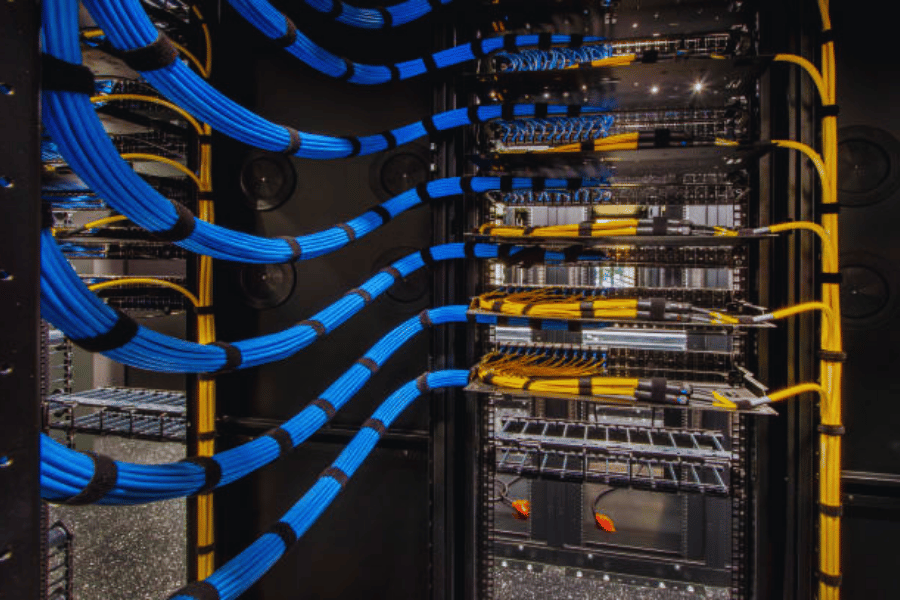
In the data processing centers, the variety of cable types that are conventionally used varies according to the use within the infrastructure. Twisted pair cables of bass types CAT5e, CAT6, and CAT6a are frequently used for Ethernet networking as they are more economical and easy to manage. Fiber optic cables, including single mode and multimode, are used for telecommunications because they allow high-speed transmission of information over long distances with a significant bandwidth and low signal attenuation. Coaxial cables are sometimes used in specific applications where heavy shielding from interference is required, even if they are not very popular. Also, directly attaching copper (DAC) cables is handy for short connections between the switches and the servers. It is necessary to choose the right cable type to enhance performance and cost-benefit ratio and meet the operational requirements of the data center.
Overview of Structured Cabling Systems
An orderly cabling method can be established through structured systems, which allow proper alignment and orderly management of wires inside the data centers. Within these systems, a fully integrated network of patch panels, cable trays, and distribution frames is included, interconnecting different network devices and elements. Structured cabling allows the data centers to be easily scalable and flexible, thus allowing new and other technologies and requirements to be quickly applied. Different types and arrangements of cables are enabled by structured cabling, which guarantees efficiency even when there are minimal power outages or interruptions. Because of its modular structure, maintenance is made more accessible, and faults or problems are detected, which enhances the data center’s overall performance.
Understanding Fiber Optic Cables
Data centers rely on fiber optic cables used for data transmission as pulses of light encased in glass or plastic strands. These cables are preferred for long-distance communication as they have good signal integrity. Single-mode and multi-mode fibers are among the data center’s more commonly used fiber optic cables. Single-mode fibers have a lower core, which increases the chances of just one light mode passing through, allowing for longer transmissions as they have low thickness and speed due to low power loss. At the same time, multi-mode fibers have high cores that support multiple light modes; however, has low distance encoding capabilities owing to modal dispersion. This enables them both to have increased resistance towards electromagnetic interference and a decrease in signal loss rate compared to cable wires. With these factors in mind, knowing the characteristics of the fiber optic cabling that would best suit your data center is essential.
Choosing the Right Power Cable for Your Needs
Choosing a power cable correctly is vital for any data center’s effective and safe functioning. The main parameters to assess are the capacity rating of the cable, the type of insulation, and environmental conditions. Calculate the total power consumption of your devices to arrive at the correct A and V rating. Furthermore, consider the environment in which installation is to be done; for example, if it is a harsh environment, the cables should be rated for heat and moisture. A good insulation material can minimize electrical risks and increase the reliability rate of the power cable. Ensure that there is conformity with the hardware already in place and that set standards and laws are met. This assessment can enhance a data center’s effectiveness and protection measures.
How Does Cable Management Impact Data Center Efficiency?
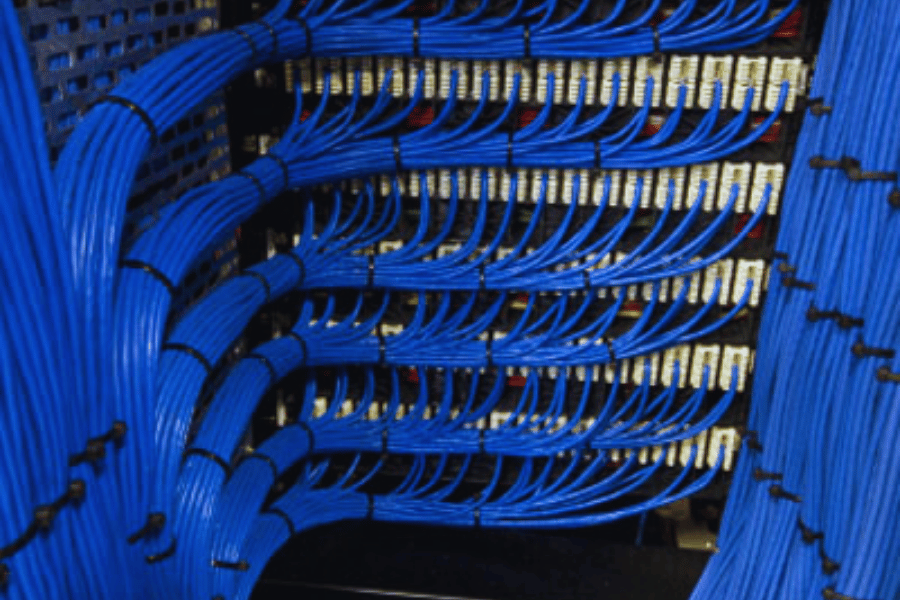
Benefits of Effective Cable Management
Effective cable management remains critical in augmenting operational efficiency in any type of center. First, it still enhances performance with increased air movement while preventing overheating through less cooling system disruption, thus best ensuring temperature control and energy efficiency. Moreover, it facilitates more straightforward diagnosis and corrective maintenance procedures by organizing wires methodically to aid in the accessible location of faults. In addition, effective cable management enhances safety by decreasing the possibility of accidental triclosan abuse and even fires caused by loose or tangled cables. Of course, improving the overall look of a facility also helps create a more business-like and tidy environment conducive to more efficient data center functions.
Common Challenges in Data Center Cable Management
One look at the challenges cable management poses in a data center environment is enough to tell one of its adverse effects on operations. One more concern is the size and amount of the cabling systems, which results in congestion and makes tracing cables impossible during maintenance. Such congestion creates low pressure that reduces airflow and threatens sensitive devices with overheating. Second, all system changes and enhancements must consider the cabling geography because otherwise, services will be interrupted, but changes that are not too frequent may cause tangles. Furthermore, there is the added complication of making short cable runs to lessen delay while keeping the installations neat and easy to reach. To successfully tackle these issues, such design set out, ongoing inspections, and the use of suitable management applications to facilitate the organization of order within the structure.
Solutions for Improving Cable Management
Structured cabling in data centers is perhaps the most pertinent solution for effective cable management. Such systems should be well thought out and implemented with color codes and labels, as this would ease identifying and isolating any cable issues. Also, using vertical and horizontal cable managers control the route path of the wires and assists in the better utilization of space and improved airflow. This can also be complemented by the arrangement of the cables in the structured cabling system, which will be more accessible and more scalable for the type of cabling deployed in the data center. Lastly, implementing a rigorous schedule of audits and maintenance practices would ensure that the best practices remain in check and that any issues can be dealt with before affecting the operations.
What Are the Latest Structured Cabling Standards?
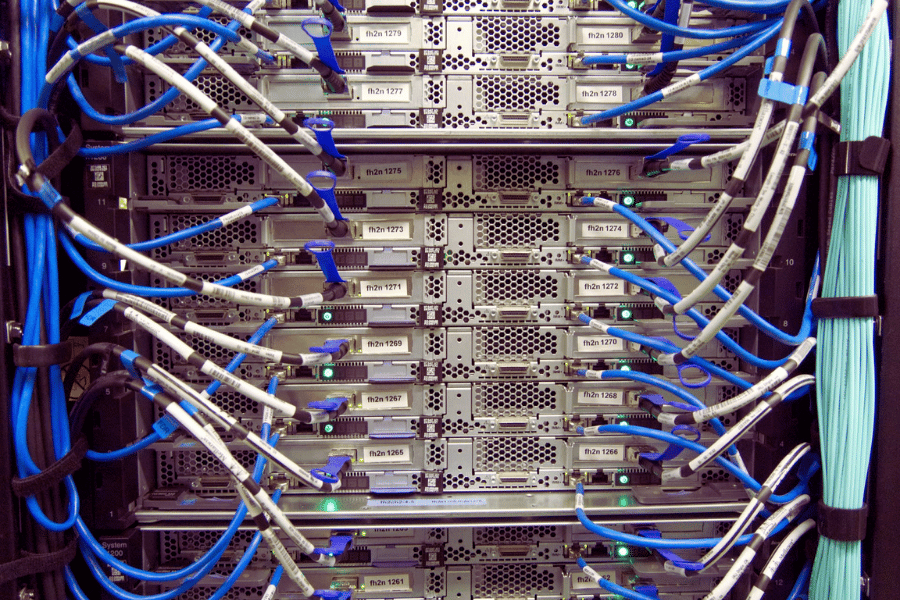
Critical Standards for Data Center Structured Cabling
The most recent structured cabling standards greatly support the progression of data centers as they allow for maximum operations. One such standard is the ANSI/TIA-568 series, which is crucial as it formulates telecommunication cabling systems’ regulations in the data center’s telecommunications infrastructure. This standard recommends cable plant topology, performance, and system-level configuration. Another essential document is the ISO/IEC 11801, which provides a uniform standard for the type of cabling used in data centers to achieve interoperability and performance standards of minimum failures in installing data centers worldwide. Moreover, the ANSI/BICSI 002 standard deals mainly with the appropriate data center design and building infrastructure, considering cable routing, redundancy features, and ecological issues. These standards are instrumental in ensuring future-proofing and reliability of cabling in data center facilities and also assist in preserving interoperability within them.
The Role of Cabling Standards in Data Centers
One of the key features within the data center is the cabling standard, being a communication system, its expansion, and its readiness for the future. Industry leaders like CommScope, Panduit, and Belden claim that cabling standards allow for easy transition and assimilation of new devices and technologies. Also, those standards define the data centers’ characteristics, making this place highly reliable and performing an essential role in the latest IT environments’ server requirements. Standards such as ANSI/TIA 568, 11801 ISO/IEC, and ANSI/BICSI 002 form a robust, compact environment that promotes easy and speedy device maintenance while lowering user risks. As stated in these guidelines, the operators of the data center will be in a position to configure the structure based on the current requirements as well as make it ready for any other future developments that will relate to network cabling.
How to Optimize Your Data Center Cable Management System?
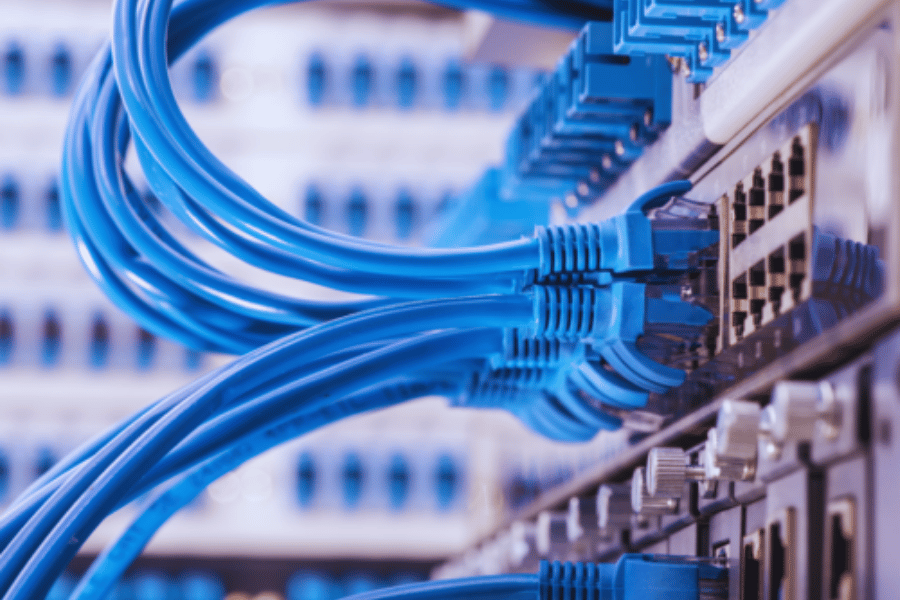
Steps to Implement an Efficient Cabling System
- Evaluate and Strategize: To start things off, it is critical to evaluate the cables utilized by your data center to determine which areas have deficiencies and where improvement is needed. This begins with comprehending the requirements for your data center, such as bandwidth requirements, and assessment of future needs for growth. It is necessary to plan for expansion as new technologies are developed or the amount of data to be stored increases in the data center’s infrastructure.
- Embrace Structured Cabling: This makes it possible to adopt a structured cabling system that will result in orderly, flexible, and efficient handling of cables. Due to modularity, a structured cabling system is easier to handle, and complexity in the cable system is minimized, factors that are necessary to promote a neat and orderly setup while simplifying maintenance and upgrade processes.
- Cable Management: Every cable must be appropriately labeled and documented to connect it to the data center, assisting in cord identification during repairs for troubleshooting purposes. This stage significantly reduces idle time and maximizes the rate at which problems can be acknowledged and fixed. All help desk documentation on cabling system issues should be updated routinely to remain accurate as configurations change.
- Implement Cable Management Measures: Use cable trays, racks, and ties, among other cable management equipment, to bundle cables systematically and prevent them from becoming knotted up. Clearing air flow helps improve air movement and minimize the risk of excessive heating.
- Monitor and Maintain: Regular assessment and care of the cabling system are key to its optimal functionality. Therefore, inspection for damage, functional testing of cable links, and amending the labeling and documentation as required are provided. Moreover, routine maintenance is instrumental in detecting probable problems before they progress to system failures.
Compliance with these guidelines will help the data centers have better cable management systems that improve efficiency, enhance operation chances without interruption, and prepare the environment for future expansion.
Integrating Cable Management Solutions
Integrating effective cable management solutions is essential for enhancing system performance and reliability. A collaborative format integrating cableways and planning is suggested by contemporary best resources to be prepared for future growth while minimizing disturbances. An advanced cable management system enables remote monitoring and diagnostics, simplifying maintenance work and reducing system downtime. Furthermore, deploying a tailor-made cable distribution head can improve the space available and the free flow of air while processing the heat internally, improving efficiency. All these approaches enhance the firm’s capabilities to embrace current and subsequent technological advancement requirements.
Best Practices for Data Transmission Optimization
When transmitting data, it is crucial to maintain and optimize its speed, consistency, and resource utilization. The outstanding websites ranking highest within this niche address the following practices in particular:
- Use Protocols that Work: Improving protocols such as TCP/IP with QUIC technologies for mobile traffic can greatly improve transfer speed.
- Control Network Bandwidth: Anticipating congestion and optimizing the available bandwidth using QoS measures like rate limiting frequently dramatically aids in maintaining flow over the network.
- Employ Data Scridcompression: Methods like using the gzip option compression for data files decrease the volume of data transferred, reducing transmission time and bandwidth requirements.
These practices are imperative for improving data transmission and ensuring the systems perform at their best. They can fully cope with the escalating amount of data required.
What Are the Best Practices for Rack and Patch Panel Configuration?
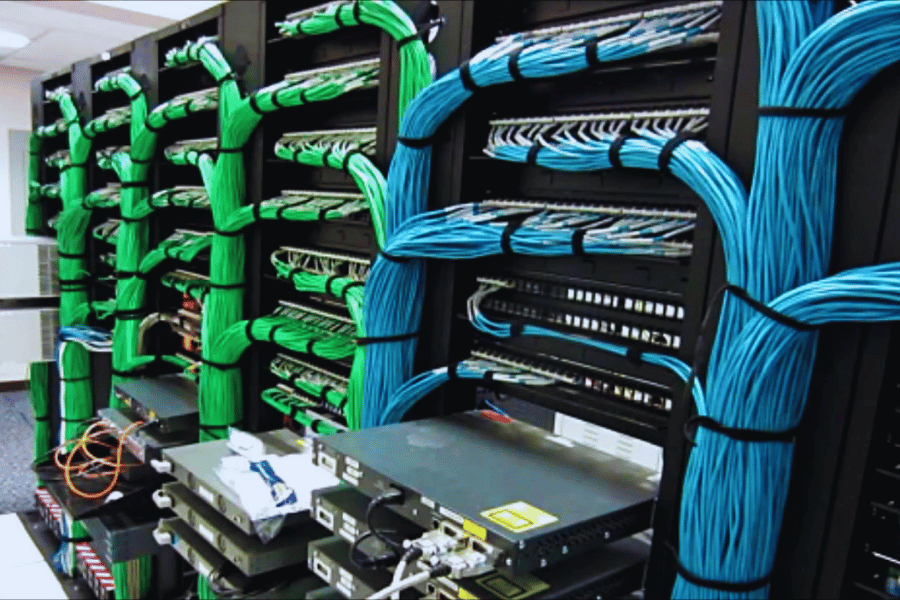
Configuring Patch Panels for Maximum Efficiency
It is essential to follow certain practices when setting up patch panels to ensure optimal performance and ease of management. First, cables must be carefully organized and all elements documented to reduce the potential for maintenance errors. Second, maintaining orderly and tidy data cable management in the data center is essential, for example, using bundle ties/ rings or cable rails to prevent cable tangling or stress on connectors that might break the cable. Additionally, positioning patch panels to which users have regular access also aids maintenance and reduces time spent during troubleshooting. Finally, using modular patch panels makes adding additional user subscriptions more flexible and more straightforward as the network expands. These measures all support one another and improve the overall patch panel configuration, as the most reputable online sources discussed.
Optimizing Rack Layout for Cable Organization
Efforts and strategies are needed to execute the best practices within this delicate environment while considering the proper placement of server racks. As suggested by leading authors, best practices for cabling in data centers include devising ahead of time. Place high-density components at the lower part of the rack units to facilitate airflow and reduce overheating. Additionally, this facilitates thermal management and increases the mechanical stability of the server rack. The second step is horizontal and vertical cable management, preventing cables from tangling and enabling fast wire access. Installing cable trays or ducts would further mitigate electromagnetic interference between power and data cables for better performance. Leave enough gap between the racks to allow for future expansion while enhancing maintenance and repair activities. These principles will give organizations an optimal and straightforward rack layout, improving cable management and network performance.
Ensuring Reliable Connection Points within a Data Center
Integrating a dedicated telecommunications infrastructure meeting the expectations of other data centers within the industry recommends, first of all, quality connectors and cables and dual redundant pathways for employees responsible for regular inspections and maintenance. In addition to performance requirements, this practice minimizes the likelihood of incidents based on loose connections, cable and connector wear-and-tear, etc. As per redundancy in a system, dual power and network connections provide an alternative point to communicate with the system in the event one of the connections fails. As an afterthought, consistency in documentation and labeling of cabling within the network and network supervision makes the troubleshooting processes easier. Thanks to this policy, data centers would improve reliability and performance in the network cabling connection points.
Reference Sources
Frequently Asked Questions (FAQs)
Q: What are the principal categories of a data center’s cabling infrastructure?
A: A data center’s cabling infrastructure’s principal categories are structured cabling, point-to-point cabling, and zone cabling. Among the three, structured cabling remains the most ideal and organized, employing pyramidal systems of cable circuits and outlets. Point-to-point cabling renders a direct path between two or more devices, while zone cabling employs a hierarchy of intermediate connection points to afford the overall system some flexibility.
Q: How can the data center operations be enhanced regarding cable management?
A: Cable management practices go a long way in the enhancement of the data center operations, which, through improved airflow, would, in turn, reduce cooling costs, establish lower downtime, make maintenance and upgrades easier as well and anticipate future upgrades like Instarene, i.e., compartmented ways of communication systems that more rapidly and cost-effectively solve problems facilitating repair and increasing overall efficiency and robustness of the data center.
Q: What are examples of standard operational procedures for power cabling in data centers?
A: Standard operational procedures for power cabling in data centers include color coding of cables tailored for appropriate voltage levels, having power cable rings incorporated into secondary substitutes of power partitions, careful estimation of cables supporting loads including AC and DC, making use of second-order cable distribution elements like elevated cable pathways plus systems of floors and undertaking scope and periodical examination plus preventive repair of cables and connections designed for power supply.
Q: What are the significant differences between cables for enterprise data centers and those for smaller data centers?
A: An example is an enterprise data center with more complicated and larger-scale structured cabling solutions, often with more advanced fiber optic backbone cabling. In small facilities, this is not the case. There may be some cabling, but it is less complex and cost-effective in managing a data center to lower costs. Another advantage is that enterprise data centers have more advanced cable management systems and may need specialized high-density connectors.
Q: What aspects should be paid attention to when picking cable products for a data center?
A: When picking cable solutions for a data center, it’s essential to understand the performance specifications (bandwidth and speed), future expansions, existing systems, mechanistic strength, rating, and minimum requirements. It is also necessary to have the correct cable types (copper or fiber optic) based on the length of the cable and the type of data center it will be used in while protecting against electromagnetic interference.
Q: What measures can either of the data center operators take to improve cable management in an existing establishment?
A: The existing facilities can improve cable management practices by utilizing cable management tools such as vertical and horizontal cable managers, having proper and systematic labeling of both cables and systems, decommissioning abandoned and other unnecessary cables, rationalizing installation of wires based on type and function and deploying modular cabling alternatives. Assistance is possible through the regular conduct of audits and the maintenance of the cabling facilities, which could also identify gaps.
Q: What role do connectors play in efficient data center cabling?
A: Connectors are needed in high-density cabling solutions, installation, maintenance, and, most importantly, circuit and system integration processes. The importance of these connectors becomes quite evident when implementing higher speeds into modern data center devices as appropriate connectors must be available, for example, RJ45 for copper or LC for fiber optics.
Q: In what way does adequate data center cable management assist in sustaining efforts?
A: Adequate cable management assists in sustaining efforts on a fundamental level by improving airflow and, therefore, cooling requirements, ultimately lowering energy consumption. It also enhances equipment lifespan by inhibiting excessive heat and reduces electronic waste by minimizing replacements. Furthermore, efficient cabling management facilitates easier upgrades and adaptations, increasing the total life and efficiency of the data center infrastructure.
